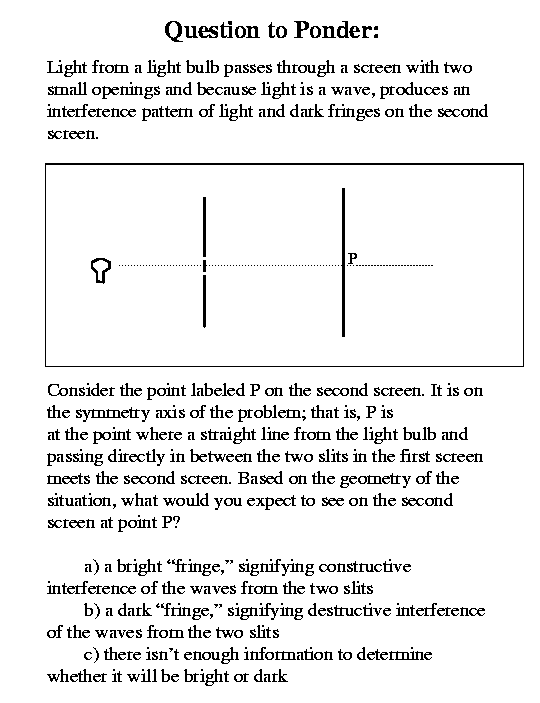|
|
Baby, your mind is a radio Got a receiver in my head Baby, I'm tuned to your wavelength Lemme tell you what it says: Transmitter! Oh! Picking up something good Hey, radio head The sound of ... a brand new world Talking Heads, Radio Head |
Assignments:Problem Set #1due 28 January, 5pm
Read Chapter 6, pp. 83-92 (helpful for upcoming lab and observing lab)
Check out these Telescope/Observatory Websites: |

In Class:
---------------------------------------------------------
review:
light is a wave
- diffraction, interference effects
- can't occur for particles; must be a wave phenomenon
Thomas Young measures the wavelength of visible light
-- less than a millionth of a meter
-- 400 to 700 nm
-- has very high frequency
-- speed = 3 x 10^8 m/s
-- frequency = speed/wavelength
= 3 x 10^8 m/s / 500 x 10^-9 m
NOTE: use common units!!!
= 6 x 10^14 /s, or Hz
= 600 trillion times per second or Hz
-- frequency range of visible light: 430 to 750 trillion Hz
------------------------------------------------------------
OK, so if light is a wave, why can't it have wavelengths or
frequencies greater or less than these values?
-- It can
-- light can have any wavelength it wants
-- we just might not be able to see it
-- but we can detect it
-- the electromagnetic spectrum
-- visible light is only a small (but important) part
-- longer wavelegnths -- infrared, radio
-- shorter wavelengths -- ultraviolet, xrays
-- all are forms of light
-- same speed
-- characterized by wavelength and frequency
-- consequences of the fact that different kinds of light
have different wavelengths: radio telescopes
-- waves "reflect" or bounce off surfaces that are smooth
compared to their waelength
-- your bathroom mirror has to be smooth to something like
one ten millionth of a meter
--that's why it covered in glass
-- note that when it gets fogged, it's no longer smooth
-- optical telescopes must also have surfaces that
are very accurate
-- however radio telescopes do not
-- radio waves are cm in size;
-- need surface smooth to cm
-- radio "dishes," satellite "dishes"
-- Arecibo telescope is made with something like chicken wire
--> big advantage: you can make big radio telescopes
WEB telescopes: Arecibo and Effelsberg 100m
OK, if light is a wave, what kind of wave is it?
water waves propagate through water
sound waves propagate through air
what's the medium for light waves?
- this was a major concern in the 19th century
- waves need a medium, and wlight is definitely a wave
- JC Maxwell found out late in the 19th cent that light results
from the complicated interplay of electric and magnetic fields
a changing electric field creates a magnetic field, and
a changing magnetic field creates an electric field
E and M fields are created by charged particles, like
the electrons and protons in atoms
When these charged particles move, they create changes in
the electric and magnetic fields around them
those changing fields give rise to light waves
The cool thing about light is that all it needs is a start
it is self-sustaining
does not need a medium <<<-- very un-wave-like>>
other waves need the restoring tug of the medium to
communicate the wave and transport energy
light basically tugs on itself
energy is continuously converted from E to B energy
and back
So light can propagate without a medium.
Then it's essentially just bits or streams of energy
just as any wave is
except that's all it is.
Light is the propagation of energy through free space.
If only it were that simple.
|
![]()